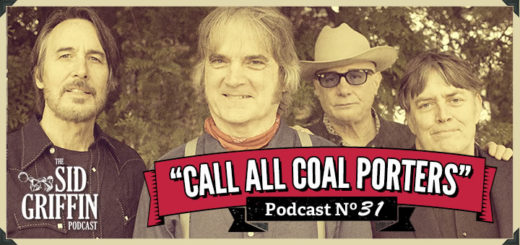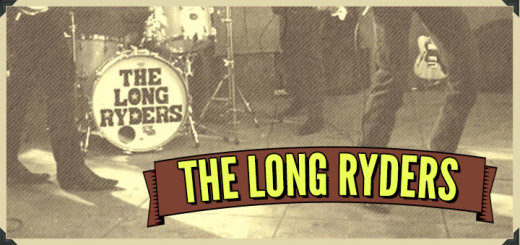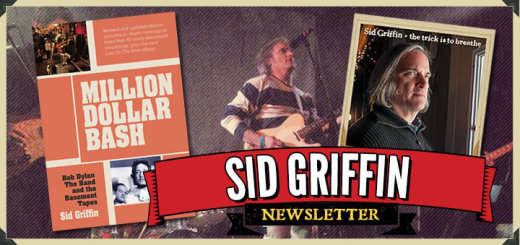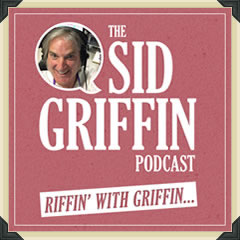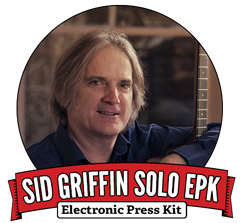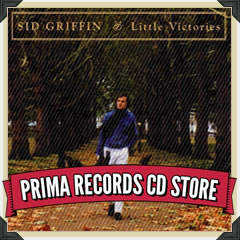Stomp and Stammer cover story – The Long Ryders
As featured in the January 2009 edition of Stomp and Stammer
Written by Fred Mills
Twenty-One Years After Their Initial Breakup, The Long Ryders Are Saddling Up Once More
Nowadays it’s easy to forget, in this post-No Depression milieu where groups like Whiskeytown, the Jayhawks and the Uncle Tupelo/Son Volt/Wilco axis are icons routinely namedropped whenever the notion of “alt-country” is invoked, that once upon a time it seemed novel for an indie-rock band to wear boots, Levis and buckskin jackets, cite Gram Parsons as an influence, and employ mandolins, banjos and steel guitars as key components in their instrumentation. In the mid ’80s, however, that was precisely the scenario in America. Back then, if an artist came out twanging, it was more than just novel – it was borderline subversive.
Such was the case with the Long Ryders, who formed in L.A. in ’82 and during their five-year tenure operated at the forefront of the so-called “Paisley Underground” scene. Even among their peers they stood out. With the possible exception of Green On Red, the Ryders’ sound, which incorporated such influences as the Byrds, Flying Burrito Brothers, Mel Tillis, Merle Haggard, the Flamin’ Groovies, NRBQ and the Buffalo Springfield (the front cover of their first album was even an homage to the sleeve of unreleased Springfield LP Stampede), was markedly different from the psychedelia of the Rain Parade and Dream Syndicate or the pure pop of the Three O’Clock and the Bangles. You could call it proto-Americana, but it wasn’t calculated as such; the Ryders simply played the kind of music they wanted to hear, and not too many other bands were playing it at the time.
By the time the Ryders called it a day in 1987 they’d topped the college radio charts, tasted major label success in the U.K, had headlined overseas festivals in front of tens of thousands of fans and entered the households of countless American homes via a now-notorious Miller beer TV ad campaign (more on that shortly…). Yet two decades is a long time in music biz years, and in 2009 the group’s pioneering efforts in making der twang und strum palatable for punks and alterna-rockers alike are largely overlooked. Just to cite an example, one of last year’s most talked-about Americana-themed music books, Pitchfork contributor Amanda Petrusich’s It Still Moves: Lost Songs, Lost Highways, and the Search for the Next American Music, contains nary a reference to the Long Ryders, a glaring omission by any measure but also unfortunately indicative of how myopic the Pitchfork generation can be sometimes (if a tree falls in a forest and no blogger is there to post the news, does it make a sound?).
The Long Ryders, however, were among the most beloved bands of my generation, pre-Internet music geeks raised on college FM and swapping live tapes as if passing along c90-sized Holy Grails. This was our music.
The Long Ryders trace their roots back to Nuggets fetishists the Unclaimed, which operated in L.A. from 1979 to late ’81, at which point the band split into two camps when guitarist Sid Griffin and two other members felt a need to expand their musical palette beyond Sixties garage. Well, it wasn’t a total break, judging by an early musicians-wanted ad Griffin ran that reportedly read, “the Byrds, Standells and Seeds ride again,” although subsequent ads would also mention Buffalo Springfield and Creedence Clearwater. Griffin, interviewed from his current home in London, clarifies the matter now by saying, “What we or I consciously sought was the melodic power of Byrds/Springfield with the rhythm section punch of the Clash/Sex Pistols. And we came close.”
Indeed, following several interim versions of the band (one very early incarnation included Steve Wynn, who left after a couple of months to concentrate on the Dream Syndicate) and a 1983 EP, 10-5-60, the Long Ryders settled on their classic lineup: Griffin and Stephen McCarthy on guitars, Greg Sowders on drums, and Tom Stevens on bass. Griffin, McCarthy and Stevens hailed from Kentucky, Virginia and Indiana, respectively, and each had an affinity for roots and heartland music (McCarthy was already a veteran of several country bands) while Sowders, as the group’s resident L.A. native, brought a punk rock sensibility to the group. Griffin emphasizes that the group really was a sum of its collective influences – setlists were as likely to include covers of the Velvets and Chocolate Watchband as Buck Owens and Merle Haggard – and not a genre exercise: “The C&W element really came in with Stephen joining up. I was amazed when he suggested we do stuff like ‘Brand New Heartache’ or ‘Lonesome Fugitive’ and we did them live and these punk kids went bananas! Yet the Long Ryders had elements of psychedelia and folk in there , what later became Americana, [so] those that called it country-rock or cowpunk kinda missed the point.”
Early 1984 found the band gigging steadily in and around L.A., honing their soon-to-be-estimable live act. By then the aforementioned Paisley Underground was in full blossom, and it wasn’t uncommon to see that scene’s groups sharing bills and, in some instances, households. Recalls Griffin, “I lived in a house with one of the Bangles, another dear friend who was a roadie for all these young bands, Billy Bremner of Rockpile, and sometimes Eric Burdon of the Animals. Some of the Green On Red guys were around the corner, and the house where various Bangles and Dream Syndicate and Rain Parade folks were was a fifteen minute walk away… [At] barbecues a lot of plans were formulated and a lot of friendships made.
“What then happened was bands went out on the road and were getting interviewed and several started poo-pooing the scene, saying they were not part of any scene or underground or particular situation at all and wanted to be judged on their own merits. Which is fair enough. I was puzzled by that attitude then but I get it more now. I was thrilled to be part of something greater than myself, I saw it as a big musicological/historical/cultural happening and was thrilled, thrilled, thrilled to be part of it. I felt it was like Liverpool in 1961-1962 or NYC in 1975 and I was happy to play a small role in it. Still am!”
Stevens, interviewed from Indiana, agrees, citing a “true camaraderie among several bands, like Green on Red, Rain Parade, Dream Syndicate, Three O’Clock, the Blasters and X, to name a few. That said, some were seriously aware of the competitive element. Playing with some bands, like Green on Red, was easy – if we were both on the same bill we’d flip a coin to see who went on first. Others would insist upon headlining no matter what. But there was never tire-slashing or fistfights, either. Later, I played in Junk Yard Love with [Green On Red’s] Chris Cacavas and he played in my band along with Will Glenn from the Rain Parade. I produced [Green On Red’s] Jack Waterson’s Whose Dog CD, and he produced my Another Room release. So the camaraderie did not end when the bands broke up. Most recently, I had a good email chat with Matt Piucci [Rain Parade], and he sent me some of his new material, and Chris Cacavas wrote me just last week, saying kind words about a new song I’d posted on MySpace.”
Stevens also recalls the earlier period as a time of “promise and possibilities” for the Ryders. “We were playing both great shows with electric guitars and lap steels one day, then beautiful all-acoustic shows the next. It was all part of the sound of new ground being broken. We felt free to wear our wide influences on our sleeves, but also to experiment and push all of the traditions and music we loved forward with lots of energy, attitude, and good humor.”
Having amassed a sizable local fan base, the Long Ryders hooked up with respected indie Frontier Records and recorded their long-playing debut, Native Sons. Stuffed to the gills with soon-to-be-classic Ryders tunes like McCarthy’s thumping “I Had A Dream,” a Griffin/McCarthy countrypolitan twanger called “Final Wild Son” and a dreamy slice of 12-string jangledom, “Ivory Tower” (featuring ex-Byrds Gene Clark, pictured here with the band, on guest vocals), it was an instant hit among fanzine critics and college radio deejays, and the band hit the road in earnest to promote the album. Rick Gershon, a music industry veteran who nowadays works as a senior publicist for Warner Bros., was running the group’s fan club and he remembers things happening “very quickly. They worked very hard to build up a small loyal following through college radio in America – like every other band at the time, R.E.M. being the prime example. Then the Long Ryders go overseas and all of a sudden they’re on the cover of the New Musical Express!”
The English music press has always had a tendency to go ga-ga over American acts it perceives to be operating outside of the mainstream – grunge bands discovered this, while more recently the Kings Of Leon became cover stars in Britain – and the Long Ryders were the latest U.S. group to benefit from the weekly papers’ largesse. “Upon our arrival in the U.K.,” says Stevens, “we were greeted with sold out shows, amazing crowd receptions, the cover of NME, and literally twelve record companies at our London hotel door after our second London show.” As Gershon puts it, “We kind of thought, ‘Is this really happening to us? Does this mean our ship has finally come in?’”
When the dust cleared, the Long Ryders were clutching a contract with Island Records which quickly put them into a British studio with producer Will Birch (of powerpop legends the Records) to record 1985’s State of Our Union. Hit single status arrived by way of Griffin’s “Looking For Lewis and Clark” – ironically, one of the band’s least roots-sounding tunes, a swaggering slice of garage far closer to the Pistols/Clash side of the Griffin equation than the Byrds/Springfield one – and the band found itself appearing on yet more magazine covers as well as BBC television. Europe, too, eagerly embraced the Ryders: Griffin singles out an ’86 festival in Spain where they headlined in front of 100,000 punters as “probably the highest of the high points. Graham Parker and the Shot, Wilson Pickett – they were both opening for us that day. I nearly fainted.”
Alas, as the cliché goes, ’twas not to last. While State of Our Union was a success, 1987’s followup, the Ed Stasium-produced Two-Fisted Tales, failed to capitalize on the momentum despite yielding a modest hit (a cover of NRBQ’s “I Want You Bad”) and things gradually began to unravel.
“Our signing with Island in 1985 worked well for the first few months,” explains Stevens. “Then our A&R guy got the axe at year’s end [and] the new UK regime hated us. Island U.S. was also fairly useless. They never issued ‘Lewis and Clark’ as a commercial single, and we never seemed to be a big concern for any of them. Between that and the slow shift that started in 1986 to hair metal, the terrain got so creepy and hard to navigate that it put a strain on us as a band, from which we could not recover.”
Gershon, who’s worked with scores of groups over the years (notably the Flaming Lips), points out that “when a band is getting along together and they are all unified as a gang, it feels you’re doing something that’s very, very pure. Then when a band is not getting along all that well… the Ryders, towards the end, felt very dysfunctional. Naturally there were a few years where things were really good, and then there started being problems within Island U.K. And of course then came the beer commercial.”
Ah, yes. Somewhere in the middle of all this Miller Beer entered the picture, waving wads of money and promising to put bands, in Gershon’s words, “in everybody’s living rooms” via music video-styled TV ads. It seemed to make sense at the time; after all, what’s more rock ‘n’ roll than beer? And with support from their record label dwindling and in need of operating capital, the Ryders took up the offer (as did several others including the Del Fuegos, the Cruzados and— in an uncredited appearance — the dB’s). “At the time, people were starving and they needed [the exposure in America],” continues Gershon. “It was not easy to book bands on TV back then if you were a college band. Now, it’s different, of course.”
In 2009, landing your music in an ad, a film or a TV program is considered an “alternate revenue stream” and a savvy career move for an artist; back then, with sixties idealism and anti-corporate sentiment still part of the cultural mix, it was considered a career sellout, as the Ryders quickly found out when a vicious backlash kicked in. “The low point, definitely,” remembers Griffin, “was the beer commercial ruining our careers and making us so reviled. The Blasters, Los Lobos and X all did beer commercials too, but only us and the Del Fuegos got ripped for it. [It wasn’t] fair, but that is life.”
Gershon adds, “Now, ‘selling out to the man’ means ‘we’re probably going to be able to eat’! It will keep the band afloat if you can do it. It’s funny, because people are so desperate to market, all of a sudden it’s a huge advantage if you can place your music. The paradigm has shifted dramatically.”
After the release of Two-Fisted Tales in the summer of ’87 the band continued to push forward and even landed an opening slot on U2’s North American Joshua Tree tour. By August, though, a disillusioned Stevens decided to quit; he was followed a few months later by McCarthy, and while Island asked Griffin and Sowders if they wanted to cut another album, the decision was eventually made to put the beast to rest…
…and then, 17 years later, to resurrect it.
Following the split each of the band members remained active in the music business: currently, Griffin fronts alt-bluegrass mavericks the Coal Porters and operates the Prima label to release C.P. records and Long Ryders reissues; Stevens has a successful solo career, most recently releasing the Home album; McCarthy has worked with, among others, the Jayhawks and Danny & Dusty (featuring Steve Wynn and Green On Red’s Dan Stuart); and Sowders is a Senior V.P. and Head of A&R for Warner/Chappell Music. In 2003 a European booking agent approached Griffin about putting together a Long Ryders reunion, and while Stevens points out that at first there were “lingering doubts from the breakup that all members would accept,” eventually all four came on board. The summer ’04 tour of England and Europe – later documented on the 2007 CD State of Our Reunion and also coming to DVD sometime this year – was by all accounts a success for fans and band alike.
“It was a relief to remove all doubt that the roaring beast that was the Long Ryders remains fully intact from the first notes we played in rehearsal after 17 years,” enthuses Stevens. “If anyone had any confusion or doubts over the cliché of the band being greater than the sum of its parts, the example was loud and clear during each of our 2004 shows. The looks on people’s faces were priceless as well.”
“We had a blast,” summarizes Griffin, succinctly. “The Bristol, England show was one of the most electric, most highly-charged gigs I have ever heard of, much less performed in! How did it feel to be back on stage together again? It was fine. Tom Stevens was his usual old self, a true rock you can lean upon. Stephen McCarthy is a better, more inventive guitarist than ever and I loved, loved, loved his work on the lap steel on ‘And She Rides’ although I know he hates lugging it around. Greg Sowders plays on Warner-Chappell demos so he is in shape even though he is not formally in a band anymore.”
With the four men scattered across London, Virginia, Indiana and Los Angeles and all having their own busy schedules, a long-term Ryders reunion probably isn’t in the cards. But they promised each other that if the timing was right and a reasonable offer came along…
Enter Atlanta promoter Chris Chandler, a Ryders fan who’d been after the band for some time and was finally able to synch up the “timing” and “offer” parts of the equation. Plus, according to Stevens, Atlanta was always one of their favorite cities. “The shows in the mid ’80s at the 688 were always very well-attended and well-received, and I remember many bonuses that made each show stand out from being just another entry on a long itinerary. The Robinson brothers, pre-Black Crowes, would sneak in. There was a special encore [at one show] that featured us, Rain Parade and members of the Church playing. Good times.”
“This one-off certainly isn’t for money,” says Griffin. “For my own part I am coming to hang out with the guys again, always a fun thing to do. My main thing is simply wanting to see the guys. I mean, I don’t even play electric music anymore. Acoustic music is where I am right now. Still, if someone really wants to hear the Long Ryders play electric music – where do I plug in?”
Griffin, Stevens and Rick Gershon each agree that, all things considered, the Long Ryders were ahead of their time, although as Stevens modestly puts it, “As for legacy, that’s up to the fans and writers. We have no real control over how we’re perceived long-term. Those that got us back in the day need no prompting; those that missed it first time or weren’t [yet] born owe it to themselves to hear us! I am just grateful for those people that do understand and give us our due.”
“I remember when I was the publicist for Son Volt,” offers Gershon. “I was a huge fan of Uncle Tupelo, and all of a sudden another generation is discovering pure country music again, and Gram Parsons, and there’s this amalgam of rock and country music again. I thought, this sounds very familiar, I’ve lived through this once before. So yeah, the Ryders have been overlooked. The one thing that was magical: they were very pure, and it was not an affectation. They were authentic. It was very, very real – in a way, they were our generation’s answer to the Flying Burrito Brothers, while being informed by punk rock.”
At the conclusion of my Griffin interview I can’t resist lobbing this query: A hundred years from now a man wanders into a graveyard and there he spots a tombstone bearing the name “The Long Ryders.” What does the epitaph read?
Griffin: “Here lies the sound of true brotherhood. Now go form your own band.”
Coming from a man whose group always plastered the legend “The Long Ryders wish success and happiness to all bands everywhere” on their LP sleeves, that’s just about perfect.

